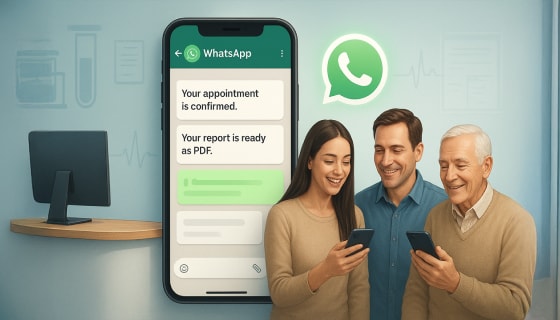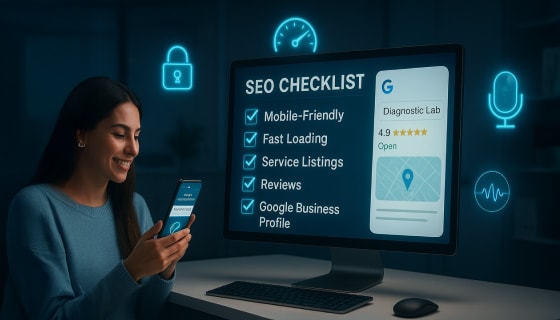Experts Approved Key Mobile-First Strategies:
- Your site should adapt seamlessly across various screen sizes, including smartphones, tablets, and desktops.
- Add Tap-Friendly CTA buttons that are easy to find and click with a thumb.
- Mobile-optimised forms should require no pinching and zooming. Booking appointments should take seconds.
- Google prioritizes mobile load speed. A delay of even 1 second can result in a 20% decrease in conversions.
Experts Approved Key Speed Optimisation Strategies:
- Compress all images and serve them in modern formats like Webp without quality loss.
- Use lazy loading for non-critical content to improve the initial display speed.
- Implement server-side caching and a reliable content delivery network (CDN) to reduce response times.
- Audit your code and remove unnecessary scripts, plugins, and tracking pixels.
Experts Approved Key CTA Strategies:
- Use action-oriented language, such as “Book an Appointment,” “Speak with a Doctor,” or “Locate a Specialist.”
- Keep CTA buttons visible and consistent across all pages, especially on mobile devices.
- Create contextual CTAs—for example, after doctor bios, add “Schedule with Dr. Patel.”
- Use contrasting colors and ample spacing so buttons stand out without overwhelming the design.
Experts Approved Key Booking System Strategies:
- Integrate a secure, HIPAA-compliant booking tool that syncs with your EHR or calendar.
- Offer multiple time slot options and real-time availability to minimize back-and-forth communication.
- Add confirmation and reschedule links in follow-up emails or SMS.
- Place ‘Book Appointment’ CTAs strategically across key pages, including doctor profiles, services, and the homepage.
Experts Approved Key Contact Experience Strategies:
- Embed Google Maps on your Contact and Homepage with a visible marker.
- Add a click-to-call button that’s mobile-optimized and easy to spot.
- Display the full address, phone number, email, and working hours in the footer of every page.
- Utilize schema markup (local business structured data) to enhance your clinic’s appearance in search results.
Experts Approved Key Service Page Strategies:
- Break services down into easy-to-understand categories (e.g., “Joint Replacement,” “Diagnostics,” “Outpatient Care”).
- Create dedicated pages for each service, with simplified explanations and patient-friendly language.
- Use icons, visuals, or before-and-after photos to add clarity and context.
- Add smart CTAs, such as “Book This Service” or “Speak to a Specialist,” directly on each page.
Experts Approved Key Doctor Profile Strategies:
- Include professional headshots (with consistent backgrounds and attire) to create visual cohesion.
- Highlight credentials, specialties, experience, and languages spoken in bullet form.
- Add a short, humanizing paragraph: “Dr. Radhika believes in…” or “Outside the clinic, Dr. Mehta enjoys…”
- Link profiles to related services offered and include a “Book with Dr. ___” call-to-action (CTA) button.
Experts Approved Patient Testimonial Strategies:
- Feature authentic, recent testimonials on high-traffic pages, such as Home, About, and individual Service Pages.
- Use short video clips, first names, or age groups (with permission) to make them relatable.
- Highlight Google review snippets or embed live review feeds.
- Group testimonials by service type or specialist for easier relevance.
Experts’ Approved Messaging Strategies:
- Add a floating WhatsApp or chat widget to your homepage and contact pages.
- Set up auto-responses during off-hours: “Hi! We’ll get back to you by 10 AM tomorrow.”
- Train staff to use clear and empathetic messaging, especially when addressing sensitive health queries.
- Integrate chat tools with your CRM or appointment system to track conversions from leads to booked appointments.
Experts’ Approved Messaging Strategies:
- Add a dedicated “Learn” or “Resources” section to your main menu.
- Use short, easy-to-read blogs that answer high-volume search queries (“What is knee arthroscopy?”).
- Create video explainers for complex procedures or post-care instructions.
- Include FAQs on service pages to handle common objections and reduce call center load.
Conclusion
And that’s a wrap!
If you’ve made it this far, you’re already one step ahead of most clinics and hospitals that still treat their websites like digital brochures. In 2025, your website should help patients feel understood, guide them to the proper care, and make booking or reaching out effortless.
The best part? You don’t need to do it all at once.
Start small. Pick 2 or 3 features from this checklist and build from there. Whether you’re running a busy multi-specialty hospital or a growing private clinic, these improvements are about making your care more accessible, more trusted, and more patient-first.
And hey, if you’d like a second pair of eyes or someone to help turn this checklist into a real action plan, we’re here for that, too.















